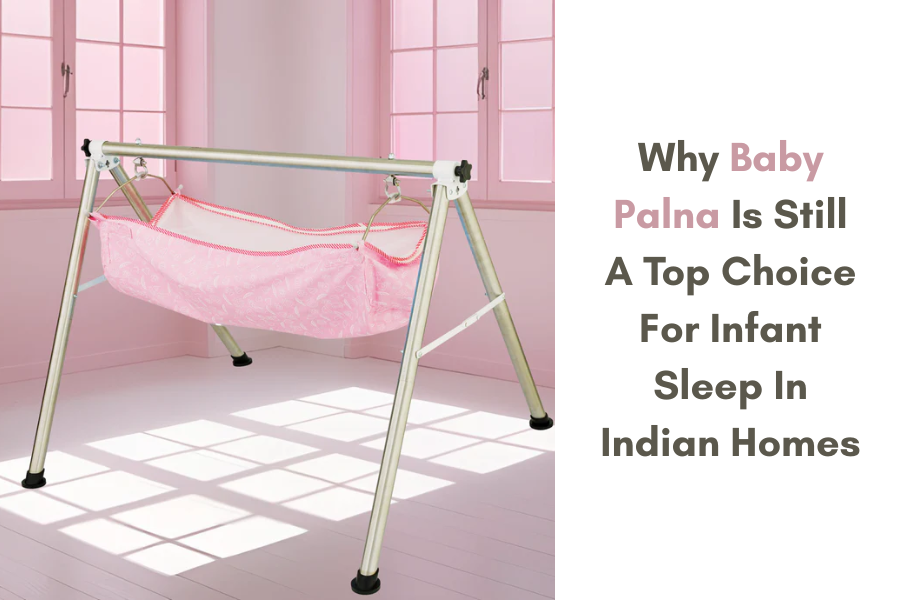Why Baby Palna Is Still A Top Choice For Infant Sleep In Indian Homes
For many Indian families, the sound of a gently creaking baby palna, commonly known as a baby jhula, is more than just a lullaby in motion; it is a ritual that has been cherished through the ages, providing a sense of comfort for both baby and new parents alike. While parenting styles come and go, the palna continues to be (at least in our culture) a tried and true, dependable practice for soothing our baby to sleep.
But why is the baby cradle swing still in the mix? And how does it maintain a balance between time-tested wisdom and everyday practicality? Let’s break it down.
The Cultural Bond With Baby Palnas
If you ask any grandparent, they will share their stories of swaying their little one to sleep in a palna made of cloth and bamboo. This was not merely about getting the baby to sleep; this was an experience. The motions of baby jhula, the soft cotton cradle, the creaking sound of familiarity, all created an experience that relaxed both the baby and caretaker.
Even now, many families in India are using the palna instead of the bulky modern crib. Why? Because it is simple, portable, and fits the parenting values we have. It is more than just a piece of furniture; it represents care, tradition, and love.
How A Palna Supports Infant Sleep
Let’s be real, sleep and babies don’t always go hand in hand. But one thing that works like magic for many parents is motion. Babies love movement because it mimics the sensation they felt in the womb. The swinging action of a baby jhula taps into that instinct, making them feel secure and cradled.
Here’s how the palna helps:
- Gentle Movement: The gentle rocking of back and forth motion can ease the baby into sleep faster and can keep them asleep longer.
- Cuddle Potential: Typical palnas traditionally involve soft cotton hammocks that allow for a gentle but snug fit around the body of the baby, providing a nice little nest to sleep in.
- Less Flat Head Syndrome: The fabric sling adapts to the shape of the baby in some situations, providing better support than flat mattresses.
- Monitoring Made Easy: Being lightweight and portable allows you the opportunity to keep the baby close while you complete other activities.
These are small-time things, but they are so important when you’ve only had two hours of sleep and a prayer.
Baby Jhula Vs. Modern Baby Cradle Swings
Some may argue that electric or modern baby cradle swings are better options. And yes, they do come with features like music, vibration, and automatic motion. But here’s where the palna still wins hearts:
| Feature | Traditional Baby Jhula | Modern Cradle Swing |
| Motion | Natural rocking, guided by hand | Automated swing settings |
| Cultural Connection | Deeply rooted in Indian parenting | Popular in urban, tech-savvy households |
| Comfort | Cloth hammock hugs baby gently | Padded seats with support |
| Usage | Ideal for newborns and daily naps | Useful for short rests and playtime |
| Maintenance | Simple, low-tech, easy to clean | May require batteries or electricity |
| Parent Involvement | Encourages bonding through rocking | Allows hands-free convenience |
That said, many parents now opt for hybrid solutions, keeping the traditional swing for home and using modern ones when traveling or multitasking.
Why Indian Parents Still Choose Palnas Today
Despite all the innovations in baby gear, the baby jhula hasn’t lost its relevance. Here’s why:
- Affordability: A baby jhula is often more economical than a swing or crib, especially full-sized.
- Space-saving: The foldable design of a palna is especially helpful in a small space, as is typical in a city.
- User-friendly: No assembly instructions or batteries, just tie it and you are ready to go.
- Generational use: Items like a palna are what Grandparents know and use the most; they will have better engagement and bonding with familiarity.
- Better sleep results: For many babies, a gentle swaying motion in a jhula can be the most calming effect.
Final Thoughts
Deciding how your baby sleeps is a big deal… So many choices from cribs to bassinets, to high-tech swings! But sometimes, the simplest solution is the best one. A baby jhula offers new parents the ease and practicality they seek, while still delivering the tradition we truly desire.
And the best part? It’s not just sleep; it’s about connection. A baby jhula is not just a swing, it’s a memory-maker, a comfort-machine, and a little piece of cultural fabric that still helps and supports parents in the most beautiful way.
Discover the perfect blend of ease, culture, and connection with Tiny Tyke’s baby cradle swing, designed to support both your baby’s sleep and your parenting journey.




